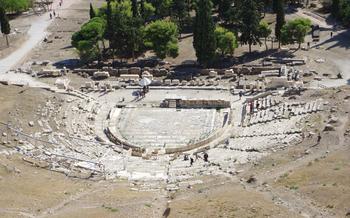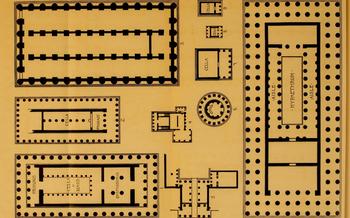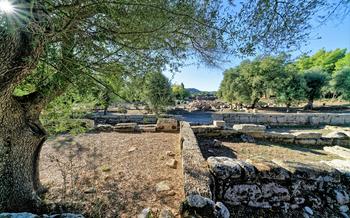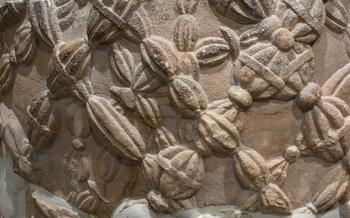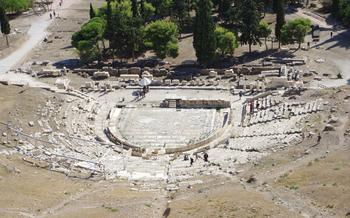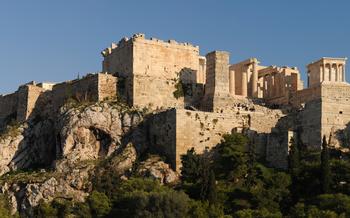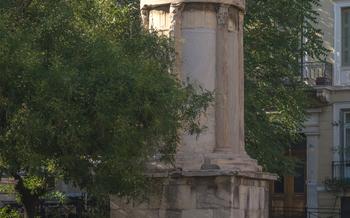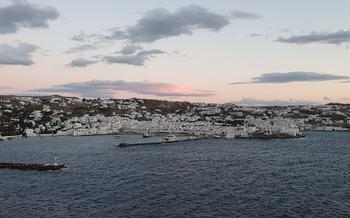
Theatre of Dion
- Historical Significance
- Architectural Features
- Performs and Events
- Seating and Capacity
- Costumes and Masks
- Scripts and Playwrights
- Actors and Performers
- Audience and Spectators
- Religious Significance
- Excavations and Discoveries
- Nearby Attractions
- Local Cuisine and Restaurants
- Insider Tip:
Historical Significance
The ancient city of Dion, located in Greece's Pieria region, holds a significant place in Greek history and culture. Its origins date back to the 5th century BC, when it served as a religious and political center of the Pierian kingdom. The city's strategic location at the foot of Mount Olympus, the mythical home of the gods, further enhanced its importance.
The Theatre of Dion, nestled within the sacred precinct of Zeus, played a pivotal role in the cultural and religious life of ancient Greece. It served as a venue for a variety of performances, including dramatic plays, musical concerts, and religious ceremonies. The theatre's impressive architecture, with its well-preserved seating tiers and intricate stage building, reflects the significance it held in ancient Greek society.
Dion's theatre was not just a place of entertainment but also a platform for promoting Greek culture and arts. It hosted major festivals, such as the Olympic Games and the Muses Festival, attracting visitors and participants from across the Hellenic world. These events showcased the best of Greek drama, music, and athletics, contributing to the cultural exchange and unity among the Greek city-states.
The Theatre of Dion bears witness to the rich history and vibrant cultural traditions of ancient Greece. Through archaeological excavations, impressive ruins and artifacts have been unearthed, shedding light on the theatre's architectural grandeur and the diverse performances that took place within its walls.
Architectural Features
The Theatre of Dion stands as a testament to the architectural prowess of ancient Greece. Its impressive seating tiers, meticulously carved from white marble, form a semicircular arrangement that embraces the stage and orchestra. The tiers are divided into sections by vertical aisles, creating distinct seating areas for different social classes. The front rows, closest to the stage, were reserved for officials and dignitaries, while the upper tiers accommodated ordinary citizens.
The stage building, known as the skene, is an architectural marvel in itself. Constructed from stone and brick, it features a raised platform supported by columns. The backdrop of the skene is adorned with intricate carvings and sculptures, depicting scenes from mythology and history. These elaborate decorations served to enhance the visual impact of the performances and create a sense of awe and wonder for the audience.
The acoustics of the Theatre of Dion are a testament to the ingenuity of ancient Greek architects. The theatre's design, with its carefully calculated angles and proportions, ensures that the actors' voices are projected clearly and evenly throughout the auditorium. This remarkable acoustic engineering allowed every member of the audience to fully experience the performances, regardless of their seating location.
In addition to the theatre itself, the surrounding structures contribute to the architectural significance of the site. The nearby temple of Zeus, with its towering columns and grand pediments, adds to the sacred atmosphere of the area. The bouleuterion, or council chamber, is another important structure, where civic and political matters were discussed. Together, these buildings form an architectural ensemble that reflects the cultural and civic importance of the Theatre of Dion in ancient Greece.
Performs and Events
The Theatre of Dion served as a vibrant cultural hub, hosting a diverse range of performances and events that celebrated Greek culture and arts. Plays, concerts, and religious ceremonies filled the air with music, laughter, and thought-provoking dialogue. Tragedies by Sophocles and Euripides, as well as comedies by Aristophanes, brought to life the struggles, triumphs, and follies of the human condition. The theatre also played a pivotal role in promoting religious festivals, honoring gods and goddesses through sacred rituals and performances. The annual Dion Festival, dedicated to Zeus, attracted pilgrims and visitors from across the region, creating a sense of unity and devotion. These events not only entertained and educated the audience but also strengthened the bonds of community and reinforced the values and beliefs of ancient Greek society. Today, the theatre occasionally hosts modern-day performances and events, allowing visitors to experience the magic of this ancient venue and connect with its rich cultural heritage.
Seating and Capacity
The Theatre of Dion boasts an impressive seating arrangement that reflects the social hierarchy of ancient Greece. The theatre's seating is divided into distinct tiers, with the lower tiers reserved for officials, priests, and other dignitaries. These privileged seats offered the best views of the stage and were often adorned with elaborate decorations.
The middle tiers were occupied by ordinary citizens, while the upper tiers were designated for women and slaves. This segregation of seating ensured that everyone had a designated place in the theatre, reflecting their status and role in society.
The Theatre of Dion had a substantial capacity, accommodating approximately 5,000 spectators. This allowed for large audiences to gather and witness the various performances and events held in the theatre. Maintaining and preserving these seating areas is crucial for preserving the theatre's historical integrity and providing visitors with a glimpse into the social dynamics of ancient Greek society.
Costumes and Masks
In the captivating world of ancient Greek theatre, costumes and masks played a crucial role in enhancing the performances and transporting the audience to distant realms. Actors donned elaborate costumes made from rich fabrics, often adorned with intricate designs and vibrant colors. These costumes not only added visual splendor to the performances but also helped establish the characters' social status and personality traits.
Masks, an iconic element of ancient Greek drama, served multiple purposes. They allowed actors to portray different characters, from gods and heroes to slaves and commoners, by simply changing their masks. Masks also amplified the actors' voices, making them audible to the entire audience, regardless of their seating location.
Moreover, masks had a profound impact on the audience's experience. By concealing the actors' faces, masks created a sense of anonymity, allowing the audience to focus on the characters' words and actions rather than the performers themselves. This heightened the emotional impact of the performances and facilitated a deeper connection between the audience and the play.
The Theatre of Dion, with its impressive stage and acoustics, provided an ideal setting for showcasing the artistry and craftsmanship of ancient Greek costumes and masks. Here, actors brought mythical tales to life, their vibrant costumes and expressive masks adding depth and dimension to the performances.
Scripts and Playwrights
The Theatre of Dion was a stage for a diverse range of ancient Greek plays, each with its distinct style and purpose. Tragedies, characterized by their exploration of profound themes and human suffering, were a staple of the theatre's repertoire. Playwrights such as Sophocles and Euripides crafted tragic masterpieces that delved into the complexities of fate, justice, and the human condition. Their works, like Sophocles' "Oedipus Rex" and Euripides' "Medea," resonated with audiences, sparking deep emotions and contemplation.
Comedies, on the other hand, brought laughter and lightheartedness to the theatre. Playwrights like Aristophanes used satire and humor to poke fun at social and political issues, offering a comedic lens on the world around them. Farces and slapstick humor were common elements in these comedies, providing audiences with a much-needed escape from the weight of everyday life.
Satyr plays, a unique genre of ancient Greek drama, were also performed at the Theatre of Dion. These plays, often performed as a concluding piece to a trilogy of tragedies, featured a chorus of satyrs, mythical half-human, half-goat creatures. Satyr plays were known for their bawdy humor, slapstick elements, and ribald storylines, offering a playful and lighthearted contrast to the serious themes of tragedies.
Actors and Performers
Acting in ancient Greece was a highly respected profession that required extensive training and skill. Actors were expected to have exceptional vocal projection, physical movement, and the ability to convey emotions through their performances. They underwent rigorous training to develop these skills, which included studying texts, practicing speeches, and working with experienced actors.
Actors in ancient Greece held a prestigious position in society. They were admired for their artistic contributions and were often treated with great respect. Some actors even achieved celebrity status and were recognized throughout the Greek world. One of the most famous actors of the ancient world was Polus of Aegina, who was known for his powerful voice and expressive performances.
Despite their high status, actors also faced challenges in their profession. Performing in an outdoor theatre presented unique difficulties, such as dealing with the elements and projecting their voices to a large audience. Additionally, actors had to contend with the often-critical and demanding nature of the ancient Greek audience.
Some notable actors who performed in the Theatre of Dion include:
- Polus of Aegina: A renowned actor known for his powerful voice and expressive performances.
- Aristodemus of Athens: A versatile actor who excelled in both tragic and comic roles.
- Theodorus of Megara: A gifted actor who was particularly skilled in portraying emotional characters.
These actors, along with many others, brought ancient Greek drama to life on the stage of the Theatre of Dion, captivating audiences with their performances and leaving a lasting legacy in the history of theatre.
Audience and Spectators
The Theatre of Dion welcomed a diverse audience, drawing people from all walks of life. Wealthy citizens and prominent figures occupied the front rows, enjoying the best views and the most comfortable seating. Behind them sat the ordinary people of Dion, from merchants and artisans to farmers and fishermen. The theatre provided a shared space where all members of the community could come together to experience the power of live performance.
Attending the theatre was not merely a form of entertainment for the ancient Greeks; it was also an educational and social experience. Plays often explored moral dilemmas, political issues, and philosophical questions, stimulating lively discussions and debates among the audience. The theatre also served as a platform for political announcements and public ceremonies, further strengthening its significance as a civic and cultural center.
The audience's reactions to the performances were varied and passionate. Applause, laughter, and cheers filled the air when actors delivered powerful lines or performed skillful feats. The audience was not shy about expressing their disapproval either, with hisses, boos, and even thrown objects serving as signs of discontent. These reactions reflected the active engagement of the audience in the theatrical experience, their emotions and opinions shaping the overall atmosphere of the performance.
In addition to the standard applause, the audience in Dion had unique ways of showing their appreciation. One such custom was the throwing of flowers and garlands onto the stage. These floral tributes were a symbol of admiration and respect for the actors and their performances, adding a touch of beauty and fragrance to the theatrical experience.
Religious Significance
The Theatre of Dion held profound religious significance, being situated in close proximity to the sacred sanctuary of Zeus. This ancient theatre served as a sacred venue for religious festivals and ceremonies honoring the Olympian gods and goddesses. During these religious events, the theatre was transformed into a sacred space where the community came together to pay homage to the divine.
The performances held in the theatre often incorporated religious themes and mythology, further emphasizing its sacred nature. Through these performances, the audience was not only entertained but also educated about religious beliefs and practices. The theatre thus played a vital role in promoting religious devotion and reinforcing the spiritual connection between the community and the gods.
One of the most prominent religious festivals held at the Theatre of Dion was the Festival of Zeus, which celebrated the chief deity of the Greek pantheon. During this festival, grand processions, sacrifices, and rituals took place within the theatre's sacred precincts. The theatre echoed with the voices of worshippers offering prayers and hymns to Zeus, seeking his favor and protection.
Attending these religious performances and ceremonies was considered a sacred duty and a privilege for the citizens of Dion. The theatre provided a communal space where they could come together, express their devotion, and strengthen their bonds with the divine.
Excavations and Discoveries
Archaeological excavations at the Theatre of Dion have been ongoing for over a century, revealing a wealth of ruins and artifacts that shed light on the theatre's history and significance. The excavations began in the late 19th century under the direction of Greek archaeologist Konstantinos Karapanos, who uncovered the first substantial remains of the theatre. Subsequent excavations by Greek and foreign archaeologists have continued to uncover more of the theatre's structures, including the stage building, the orchestra, and the seating tiers.
These excavations have yielded numerous significant discoveries, including inscriptions, sculptures, and pottery. The inscriptions, some of which date back to the 4th century BC, provide valuable information about the theatre's construction, use, and religious significance. The sculptures, which include statues of gods, goddesses, and mythological figures, offer a glimpse into the artistic traditions of ancient Dion. The pottery, which includes both imported and locally produced items, provides insights into the trade and economy of the region.
The ongoing excavations and research at the Theatre of Dion continue to contribute to our understanding of this important ancient site. Archaeologists are working to uncover more of the theatre's remains, conserve and restore its structures, and interpret its significance within the context of ancient Greek culture and history.
Nearby Attractions
Complement your visit to the Theatre of Dion by exploring other nearby attractions that offer a glimpse into the region's rich history and natural beauty. Stroll through the ancient city of Dion, where you can admire the ruins of temples, villas, and public buildings. Don't miss the archaeological museum, which houses a collection of artifacts unearthed from the site, including sculptures, pottery, and inscriptions.
For a refreshing change of scenery, head to the nearby beaches along the Pierian Riviera. Immerse yourself in the crystal-clear waters, bask in the warm sunshine, and enjoy the stunning views of the coastline. If you're feeling adventurous, embark on a scenic hike in the majestic Mount Olympus National Park, home to the mythical abode of the ancient Greek gods.
Make sure to allocate ample time to explore these nearby attractions. Each destination offers unique experiences and insights into the cultural and natural heritage of the region. Whether you're interested in history, archaeology, nature, or simply relaxing on the beach, you'll find something to captivate your senses in the vicinity of the Theatre of Dion.
Local Cuisine and Restaurants
After a day of exploring the ancient history of Dion, indulge in the region's culinary delights. Katerini and the surrounding area are renowned for their fresh seafood, succulent grilled meats, and mouthwatering homemade pastries.
For a traditional Greek dining experience, head to one of the local tavernas or restaurants. Sample the daily catches of the day, grilled to perfection and served with a drizzle of olive oil and lemon. Meat lovers will delight in the souvlaki, tender skewers of grilled meat, or the hearty kleftiko, a slow-cooked lamb dish.
Don't miss the opportunity to try the local pastries, such as the flaky spanakopita, filled with spinach and feta cheese, or the sweet baklava, a filo pastry dessert soaked in honey syrup.
To fully immerse yourself in the local culinary culture, consider taking a cooking class and learning to prepare some of these delicious dishes yourself. It's a great way to bring a taste of Greece back home with you.
Remember to support the local businesses that keep these culinary traditions alive. Enjoy the warm hospitality and delicious food that the region is known for.
Insider Tip:
For an unforgettable experience, plan your visit to the Theatre of Dion during the annual Dion Festival, typically held in the summer months. This vibrant festival brings the ancient theatre to life with captivating performances of classic Greek plays, concerts, and traditional dances. Immerse yourself in the magic as talented actors and musicians recreate the atmosphere of ancient Greece, transporting you back in time to the era of Sophocles and Euripides. Don't miss this extraordinary opportunity to witness the theatre's rich history come alive before your eyes.
